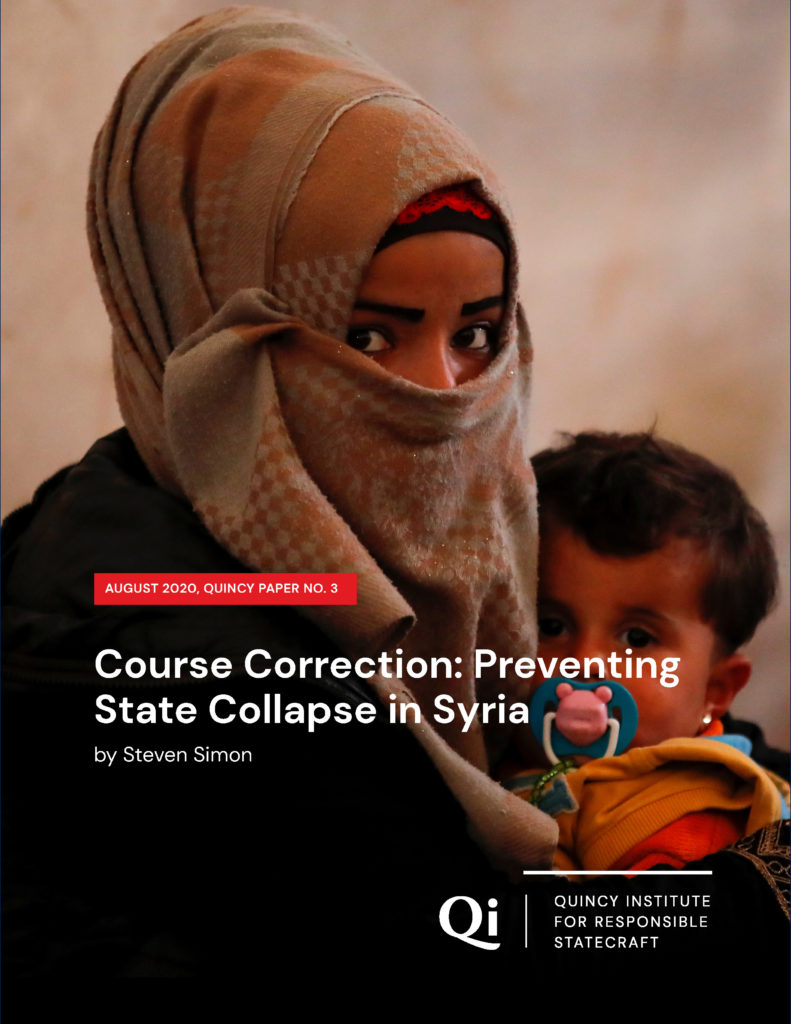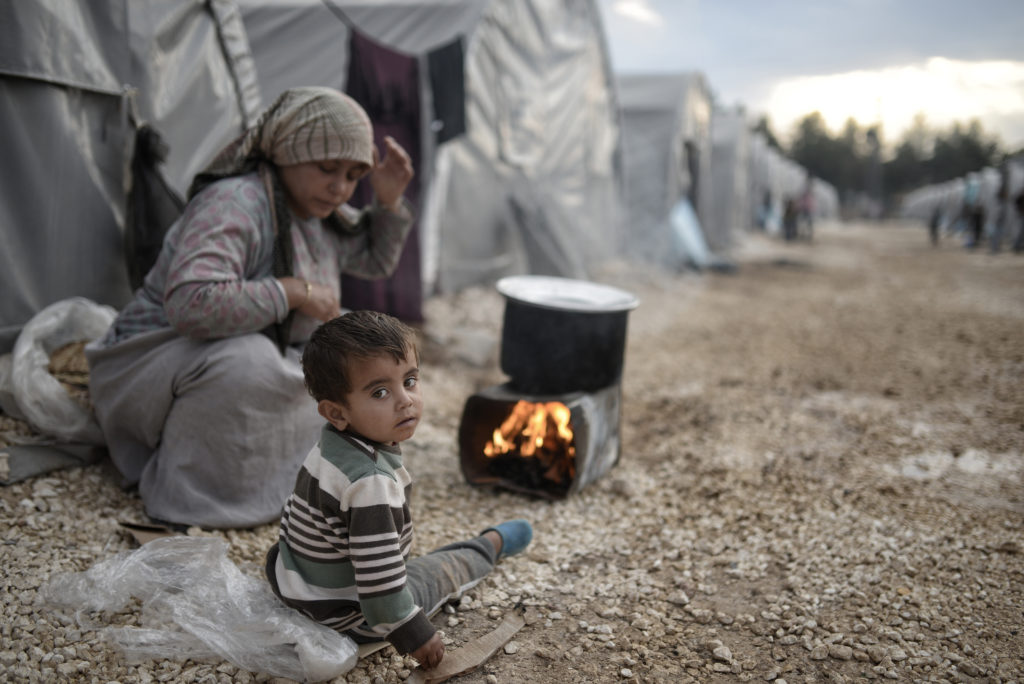Course Correction: Preventing State Collapse in Syria

Read and download a full PDF of the report here
Executive Summary
U.S. policy toward Syria deepens the suffering of ordinary Syrians while increasing the potential for a clash between Iran and Israel in Syria and possibly beyond. The U.S. cannot dislodge President Bashar al–Assad, but its policy will increase his reliance on Russia and Iran, whose influence in Syria the U.S. seeks to roll back. If kept in place unaltered, extensive U.S. sanctions on Syria, as well as on states and humanitarian groups seeking to assist its population, will tip the country toward collapse. Assad will still preside over a large swath of Syrian territory, but the rest of the country will be divided among local warlords or foreign countries heedless of the pain inflicted on Syrians under their control. This space will provide new and expanded opportunities to predators, such as ISIS, while radiating violence outside Syrian borders and setting in motion successive waves of refugees Syria’s neighbors are ill-equipped to manage. None of this serves any conceivable U.S. interest.
America’s true interests in Syria are best addressed through pragmatic diplomatic contact with Damascus and its allies. While this strategy has not heretofore received serious consideration, this paper argues that a reverse course of this kind is best calculated to preserve U.S. interest in avoiding the chaotic ramifications of state failure and alleviating suffering engendered by severe sanctions that underpin the U.S. policy of “maximum pressure.”
Whether a sanctions policy can be judged successful hinges on its objective. If sanctions are intended to produce regime change, then in the case of Syria the policy is failing and unlikely ever to succeed. If the objective is to crush Syrian society and turn Syria into a country only barely ruled by a government in Damascus unalterably convinced that surrender entails annihilation, it might well succeed. But success will come at the cost of regional stability and the awful fate of Syrians pulverized by sanctions against a government they are currently unable to influence. Assad will remain, and the U.S. will be under pressure to contain the centrifugal forces that societal collapse will unleash across the region.
Thus, if regime change remains the main U.S. objective, and creating a “quagmire” for Russia persists as a collateral aim, the U.S. will have succeeded in leaving all parties worse off. This is not generally held to be the standard for a successful foreign policy.
This assessment dictates the need for an alternative policy approach, the fundamental course correction proposed in this paper. If the Trump administration’s Syria strategy is geared toward unattainable and counterproductive objectives, what should a reconsidered U.S. policy aim to achieve? This study argues that the U.S. should have two interrelated objectives:
Avoid a failed state in Syria.
If the Syrian state were to fail, migration and internal displacement would grow exponentially and repatriation would come to a halt. Apart from the humanitarian consequences for the affected population, neighboring countries would bear the brunt of the refugee surge. Although the U.S. seeks to prevent the resurgence of ISIS in Syria, the anarchic conditions accompanying state failure would turn parts of Syria into a game preserve for militants.
Avoid escalation between Israel and Iran.
Neither Iran nor Israel is looking for a war. But in the tit-for-tat of attack and counterattack, perceptions of the stakes involved could change rapidly, especially in a situation wherein there are no rules of the road or mutually acknowledged red lines. It is essential to stanch this dynamic before it gets out of control.
To achieve these objectives, the U.S. will need the cooperation of the Syrian government and especially Russia. The U.S. will want concessions on three specific initiatives:
Syrian facilitation of humanitarian and reconstruction assistance. Reconstruction and stabilization programs work best when they are implemented through local governments. In this case, Damascus would have to cooperate in the work of NGOs on the ground, allow unfettered movement of goods and services, and refrain from diverting funds and materiel to unrelated purposes and impeding the operations of NGOs on Syrian soil.
Syrian constraints on Iranian or Iranian proxy movements in Syrian territory. The alternative to Israel’s whack-a-mole strategy is a regulated framework for Iranian activities in Syria. The government best able to negotiate and enforce such constraints is the Syrian regime itself. The U.S. would wish to see the government reach a verifiable agreement with Tehran to block destabilizing activities.
Release of arbitrary detainees, including American citizens, and agreement on International Red Cross access to detention facilities.
To secure these objectives, the U.S. will have to make its own concessions:
Suspend sanctions. Sanctions relief is essential to reconstruction and stabilization operations in Syria and to funding for essential services. Reverting control of oilfields to the government would be a vital element of this arrangement. It is also a necessary quid pro quo for Syrian cooperation.
Open a channel to the government. Although these measures could be negotiated through intermediaries, as some may have to be, a direct channel to the government would be more efficient while offering greater situational awareness.
Collaborate with Russia as well as Arab partners. Russian cooperation, along with the involvement of Saudi Arabia and the UAE, neither of which wishes to see state failure or unconfined Iranian penetration of Syria, would be vital. After nine years of brutal warfare, responsible statecraft demands that the United States abandon a policy that is disconnected from realities on the ground and its own strategic interest.
Introduction
The current United States policy in Syria is futile. There is an unbridgeable gap between the goals of policy and the commitments they imply on the one hand, and on the other the capabilities and resources available to achieve them. The Trump administration has no realistic plan for closing this gap. Compounding the disconnect between the means and ends of U.S. policy is the often incoherent and contradictory nature of the Trump administration’s rhetoric and actions, which at various times suggest that the U.S. seeks to disengage from its military commitment and, at other times, that Washington is committed to maximalist objectives of ridding Syria of Assad, trapping the Russians in a quagmire, and significantly rolling back Iranian influence in the region.
The United States’ single most important interest in Syria—preventing state failure and the attendant instability and upheaval it would create in the region—is ill-served by the administration’s campaign of “maximum pressure.”1 The current U.S. approach to Syria is counterproductive and will merely accelerate state collapse without achieving the administration’s declared objectives, as outlined below. To put U.S. policy on a trajectory that would advance America’s core interest, Washington will need to engage directly with the Assad government and rely on incentives as well as punitive measures. This approach runs directly counter to current policy, which underestimates the risks to U.S. interests of a collapsed Syrian state. Currently available policy alternatives regarding Syria reflect either an inclination to regime change or a preference for more limited aims.

Regime changers in the administration are led by Secretary of State Pompeo, James Jeffrey, the U.S. Special Representative for Syria Engagement, and Joel Rayburn, the Special Envoy for Syria. They believe that Assad’s government is incapable of reform and that starving the Syrian government of revenue will result in Assad’s removal. The assumption here is that the U.S. has the resolve to push the Syrian economy to the breaking point. The regime changers’ expectation is that once Assad has left the scene, there is at least the potential for Syria to become a more open and pluralistic country and Iran’s presence can be reduced. They have consistently blocked any positive approaches to Damascus in favor of policy that offers only punishment and no incentives to elicit more cooperative behavior from Assad. From time to time, President Trump seems to endorse a less radical approach, but Pompeo and others often wait for his attention to focus elsewhere, which it invariably does, and then proceed to undermine his apparent intentions.
‘U.S. interests are better served by stabilizing the Syrian state than by undermining it.’
A second school of thought argues for a less geopolitically ambitious and more realistic set of objectives for Syria, based on the assumption that Assad will neither surrender power nor be forced out by his patrons or domestic opponents. From this perspective, current U.S. policy will have the perverse effect of accelerating Syria’s descent into failure, thereby putting at risk the stability of neighboring states, efforts to contain Islamic extremism, and the urgent need to reduce the refugee burden on Europe and vulnerable regional countries. The argument here is that U.S. interests are better served by stabilizing the Syrian state than by undermining it.
This paper makes the case for an approach that rejects regime change, endorses cautious, carefully structured interaction with the Syrian government, aims to prevent state failure, with all of its collateral effects, and reduces the possibility of an Israeli–Iranian clash in Syria, with all of its own dangers to the fate of the Syrian people. The first section sets out and prioritizes U.S. core interests in Syria and describes the current situation in Syria and how it affects those interests. It is followed by a discussion of U.S. policy in Syria and an assessment of the sources of its failure, a prescription for what should be done to protect U.S. core interests, and how this alternative approach should be implemented. The concluding section sets out guidelines for the delivery of assistance that seek to reconcile the objectives assistance is intended to serve with the constraints it will face.
U.S. Interests and the State of Play in Syria
The U.S. has one overriding interest in Syria to which all other interests should be subordinated: to prevent the collapse of the Syrian state, so averting the further immiseration of the Syrian population, the adverse spillover effects a collapse would create, and pressure within the United States to increase America’s military presence in the region at a time when U.S. security is best served by reducing this footprint.
Over the past nine years, the Syrian people and U.S. friends, partners, and allies in the region and in Europe have suffered the calamitous consequences of anarchic conditions in Syria. The exodus of refugees to Lebanon, Jordan, and Turkey placed enormous economic and social strains on all three countries, undermining the stability of the weak and triggering intervention by the strong. There are, for example, 750,000 Syrian refugees in Lebanon, and they have already been hit hard by the unraveling of the Lebanese economy. The 2015–16 flood of Syrian migrants into Europe fueled a nativist backlash that has stoked antidemocratic movements and generated fissures within the European Union. The evolution of anti–Assad demonstrations and guerilla activity into a countrywide civil war and the emergence of a Salafi-jihadist opposition to the Assad government allowed ISIS to dominate a large swath of Syrian territory from which the Syrian army had withdrawn. Turkey, a treaty ally, was confronted with an armed Kurdish presence. Israel, in the wake of at least two attempted drone strikes, felt increasingly exposed to attack by Iran and responded with airstrikes against Iranian and Hezbollah targets in Syria.
There are multiple causes of Syria’s present fragility: the destruction, dislocation, and deaths caused by nine years of war; the cumulative effects of the preceding decade of economic mismanagement and corruption; severe drought, and destabilizing interventions by Russia, Iran, Hezbollah, Turkey, Qatar, Saudi Arabia, the United States, and others. Syria’s downward spiral will thus be difficult to arrest and reverse, but the effort to do so is increasingly urgent.




